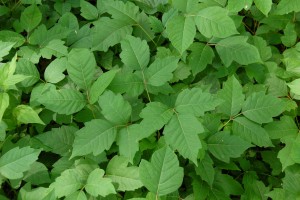What To Do After You Encounter Poison Ivy, Oak Or Sumac
What To Do After You Encounter Poison Ivy, Oak Or Sumac
Poison ivy is the most common cause of skin rash in both adults and children. In the State of Florida there is plenty of poison ivy for you to encounter. Poison ivy can grow from the ground, against a tree, or even along a fence, meaning it can show up just about anywhere. Even if the plant appears dead, it still packs poisonous oils that can get on your skin. It’s not just poison ivy that you have to look out for; similarly related plants that can also cause a negative skin reaction include, poison oak and poison sumac.
In order to protect yourself, it’s important to know what poison ivy, oak, and sumac look like and how to react if you come into contact with these plants.
 What does Poison Ivy look like?
What does Poison Ivy look like?
Some poison ivy leaves are shiny and green and have smooth edges, others have wart-like growths on the leaves. Leaves are usually a 3-leaflet design with one leaf per stem.
 What does Poison Oak look like?
What does Poison Oak look like?
Similar to poison ivy, poison oak grows as a shrub with 3 leaves grouped together, and one leaf coming off each steam.
What does Poison Sumac look like?
Poison sumac is a woody shrub that contains 7-13 leaves placed into pairs on other side of the longer parent stem. (see Picture)
Symptoms Of Poison Ivy, Sumac, Or Oak Contact
Some people experiencing symptoms shortly after coming into contact with poison ivy, for others the symptoms can take more than a week to form. By the time the itching begins, you might have no memory of coming into contact with poison ivy.
Signs that your skin is irritated from the poisonous plant include:
- Itching skin
- Streaky or patchy rashes located where skin came into contact with plant
- Red bumps that can form into blisters
The rash tends to last between 1 week and 3 weeks, ranging from mild to severe. While it can be uncomfortable and require medical attention, very few people need to be admitted to the hospital for serious allergic reactions.
What To Do After Touching Poison Ivy, Oak, or Sumac
The first thing you want to do after you come into contact with a poisonous plant such as ivy, oak, or sumac, is to wash everything with warm water and soap. The faster you can wash your skin after contact the better, it takes about 30 minutes for the toxic oils of the plant to penetrate your skin. Make sure to get all crevices and cracks, plant oils can seep into more discreet regions of your body, say for instance beneath your fingernails.
If you walk over poison ivy it will remain on the bottom of your shoes, when you take them off you risk transmitting the sap, laden with itch-inducing urushiol, onto your hands. Shoes, jeans, any clothing that comes into contact with the plant needs to be carefully removed and washed with hot water and soap right away.
If any tools or other supplies came into contact with the poisonous plant use bleach solution or rubbing alcohol to make sure any lingering sap is removed.
Treating and Preventing Poison Ivy Rash
If you are experiencing the itchy side effects of poison ivy, there are a few things you can do to help soothe the itch. If your body is warm or sweaty, your discomfort will increase, therefore it’s important to stay cool. You can also take a lukewarm bath infused with oatmeal for an instantly soothing break. You can also apply lotions with antihistamine qualities, such as calamine lotion and hydrocortisone cream to help cease itching and blistering. For more serious skin rashes, especially around ultra sensitive body parts, such as your face or gentiles, a medical professional can prescribe a steroid.
In order to prevent contact with poisonous plants you should wear proper protective clothing will outdoors near where this plant lives. You can also learn to pin point these plants when you see them, enabling you to stay away.
Whatever you do, don’t burn the plant in hopes of preventing anyone else from coming into contact with it. Many people try to burn poisonous ivy, oak, or sumac in order to dispose of it, but the smoke itself is actually toxic. If you are exposed to the fumes a very serious reaction can ensue.
When Should You Visit Urgent Medical Care For Poison Ivy?
- Visit the Emergency room or call 911 if:
- A severe allergic reaction begins, which can include severe swelling, or troubles breathing.
- If you have a history of severe reactions to poison ivy, oak, or sumac
- If you have inhaled the smoke from the plant
Visit Urgent Medical Center if:
- Itching is severe and won’t stop
- The rash is on your lips, eyes, genitals, or face
- Your rash appears to be infected, signs of which include pus coming out of the blisters, severe tenderness, or a noticeable odor.

